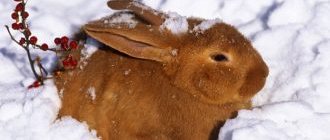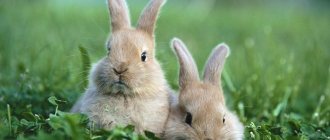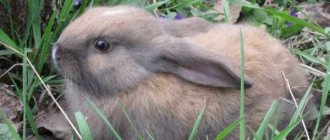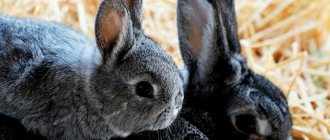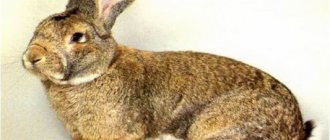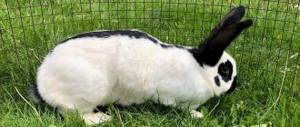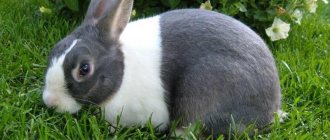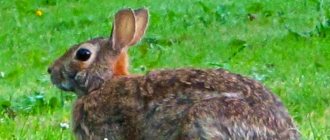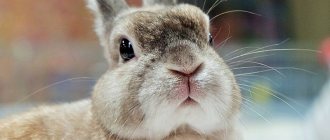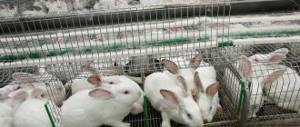History of the variety
Rexes are considered a breed that originated in France in the early 20th century. A family of Belgian giants gave birth to rabbits with short and very dense beautiful fur. This natural mutation prompted animal owners to breed them. And the new breed was called “Rex”, with a hint of the “royal” position of these animals.
In the 20s of the last century, the Russian scientist Serebrovsky, interested in the new breed, tried to take the couple out of Berlin. But according to German law this was prohibited. To get around the rules, the biologist crossed the rabbit with another species. The resulting individual differed from the “Rex” only in color, but the restriction did not apply to it. This is how the royal look ended up in Russia.
Nowadays, rex breeding is carried out even in China, and the best products from this valuable fur are produced in Spain and Germany.
History of appearance
According to the widespread version, the animals that became the progenitors of the breed were born in 1919 on one of the farms located in the south of France. As a result of a random mutation, a pair of rabbits of the Belgian Giant (Flanders) breed gave birth to babies with a very original fur structure.
Initially, the color of the rex was dark brown, but now there are numerous varieties with a wide palette of colors, even “cheetah”
The owner of the animals appreciated the prospects for breeding such unusual pets and tried to consolidate the spontaneously manifested characteristics through a series of closely related crosses. This is how a new variety of rabbits was obtained, called Rex - “royal”. In 1924 they were exhibited at the Paris International Exhibition, where they were a resounding success.
Particular attention of rabbit breeders was attracted by the fact that the skins of animals, almost without additional processing, could imitate the fur of more valuable fur-bearing animals (for example, beaver).
Over the next few decades, livestock breeders and scientists in many European countries were actively involved in the breeding and selection of rex. Some states even introduced bans on the export of animals of this breed in order to prevent the free distribution of valuable genetic material. The fur coats of the first bred individuals were dark brown, but over time, rabbit breeders received other varieties with a wide variety of colors.
Feature of fur
Rabbit fur coats used to be very poorly rated due to the fragility of the material. But with the advent of the Rex breed, the situation changed. The fur of these animals grows at right angles, it is longer and thicker than that of other species, has an extraordinary softness and tenderness to the touch and lasts much longer.
This fur has a lot of color variations - charcoal, snow, brown, gray, deep blue and various reddish shades. Its quality depends on the conditions and place of raising the rabbit, as well as the time of slaughter.
Products made from “royal fur” are usually much more expensive than any other, and it is recommended to purchase them in elite salons to avoid encountering a fake.
A special feature of the fur from Rex rabbits is its unusual appearance; it gives the impression of being shorn, all the hairs are so equal in height. In addition, products made from these skins are famous for their extraordinary lightness. The pile has a very thick structure and good moisture resistance properties.
Disadvantages of a rabbit fur coat
When purchasing such a fur product, you must immediately be prepared for the fact that it may have some disadvantages, because this is a low-cost purchase. But you should know these disadvantages in order to make a final decision about a new acquisition:
- If the frost outside has exceeded -30 0 C , then such outerwear, unfortunately, will no longer warm you, especially if you compare it with expensive furs. That is why it is better for the fair sex who live in the northern part of the country to turn their attention to fur coats made from other types of fur.
- The main negative quality of rabbit fur is the short duration of wear . Basically, the wear period is 3 seasons .
- You need to treat things quite carefully ; it is better not to give preference to public transport due to the low level of wear resistance of the material.
- If you want a full-length fur coat, then rabbit fur is definitely not suitable for this, since it is quite fragile . Therefore, for this option it is better to turn your attention to the furs of other animals.
Characteristics and description, types
Rex rabbits are quite large in size, some individuals reach 5 kg. Usually all individuals have an elegant constitution with narrow and fragile bones. The average body length of an adult specimen is from 40 to 55 cm.
Rabbits grow as follows. By one month of life their average weight is 650 g, by two - 700 g, by three - a little more than 2 kg, by four - 2.5-2.8 kg.
The smooth fur of the skin is very smooth and feels like velvet. If you run your hand against the hair growth, it instantly returns to its place, leaving no bald spots.
There are several types of rex.
Rex marder
The skin of rabbits resembles marten fur. This variety exists in two variations - regular-sized animals and dwarf ones (bred for decorative purposes).
Castor rex
This variety's coat color is always brownish. The name is translated as “king of the beavers.” There is usually a dark burgundy stripe down the middle of the back, and the sides are silver-gray. Castor has the best quality and very expensive fur; it is considered the most noble and elegant.
The least number of such animals is born in the population.
Chinchilla Rex
Less attractive in rabbit breeding, since there are many such colors in other breeds. Although the chinchilla rex has fur of much higher quality.
Mini Rex
They are bred only for decorative purposes, as pets, although their fur does not differ in quality from ordinary rexes. Rarely reach a weight of 2 kg, the usual weight is 1-1.5 kg.
There are many color options. They have a wonderful character - good-natured, cheerful and playful pets very quickly get used to coexisting with a person nearby.
Rex rabbit breed
The breed was developed through animal selection in France. Translated, the name means “royal”. Thanks to its valuable fur, the breed has become popular throughout Europe.
Rex rabbit fur is highly prized
Another famous name is castor rex, which means “king of the beavers.”
Rabbits are large in size, reaching 5 kilograms. The minimum weight of an individual is 1.5 kilograms. Externally, the rabbit's body is larger than its head. The rodent's whiskers are short, curled at the bottom.
There are individuals with no whiskers, which does not affect their sense of smell. According to the breed standard, there are about 20 colors.
The most famous:
Zoological scientists distinguish the Orylag subspecies among the rabbits. The rabbit belongs to the chinchilla order. The animal's fur is velvety to the touch and retains heat well.
Breed standard
The official description and characteristics of Rex rabbits are as follows:
- The head is small, elongated. Males are much wider and more powerful than females.
- The eyes are almond-shaped, their color usually matches the color. The White Rex has both red and blue eye colors.
- The neck is short and muscular.
- The ears are medium sized and set vertically.
- The mustache is short, curly or completely absent.
- The legs are strong and muscular. The claws are always the same color as the coat color.
- The body is voluminous and strong, much wider than the head. Females usually have a more developed dewlap.
- Weight from 3.5 to 4.8 kg.
- The coat is usually shorter than other breeds (up to 2 cm). Due to mutation, it grows perpendicular to the animal's skin. The lengths of the guard hair and the very dense undercoat are the same, which creates a velor effect. Curly hair is allowed only behind the ears. This feature of fur allows for many imitations, for example, marten.
- Colors. There are more than twenty of them. The most common are snow, lilac, agouti, black, chocolate, speckled.
- Fertility is low. The maximum number of rabbits at birth is 6.
- Performance. Up to 64% yield of suitable meat from the live weight of the rabbit.
Photo gallery of the Rex breed:
Other breeds of furry rabbits
Crossing with other rabbit breeds allows you to experiment with fur colors.
Rabbits are divided into the following types:
| Name | Peculiarities |
| Angora | Individuals with the longest hair - up to 25 centimeters. Feels like silk. Used to make yarn |
| Rex chinchilla | The most valuable fur. Velvety dense wool |
| Rex marder | Imitates marten fur |
| Flanders | The skins are dyed to resemble the fur of lynx and chinchilla |
| Castor rex | The color and hair of the animal are similar to a beaver |
Dwarf and downy rabbits are widespread. Animals are raised for their fur, with periodic trimming.
Pros and cons of the breed
The advantages of this variety of rabbits include:
- high frost resistance (up to –30 °C);
- unpretentiousness in choosing food;
- high yield;
- fairly good early maturity.
The disadvantages of the breed are as follows:
- intolerance to hot climates and temperatures above +25 °C;
- low fertility of females;
- low survival rate of newborn rabbits;
- excessive fearfulness;
- increased aggressiveness as a reaction to odors;
- Possibility of breeding the breed only by professionals.
Mr. Tail recommends: care and maintenance
Rex rabbits are kept only in specially equipped cages or enclosures. The main requirement is to prevent high crowding of animals, since in this case the rabbits begin to actively gnaw on the walls and mesh.
Cages and enclosures should be made of hard wood or high-quality metal. Plastic is unacceptable, as rexes easily chew it and can significantly harm themselves.
The bottom of the cage can be solid or made of fine mesh. The bedding is made of straw, hay, sawdust, in which small fractions are unacceptable.
As feeders and drinkers, it is necessary to give preference to suspended structures, since floor ones get dirty too quickly.
The best types of drinking bowls for Rex are vacuum ones; they are convenient for adding water and vitamins.
The feeder is installed with a special design, it is fixed outside the cage, filled with hay and feed and hung on the wall when filled. Place the container in such a way that rabbits can easily get food, but cannot drop it to the bottom.
Rexes tolerate low temperatures, down to –30 °C, but do very poorly in hot climates.
Otherwise, care is the same as for other breeds. Decorative rex rabbits do not have to be kept in cages in the house; they also live well in spacious cat houses; a litter tray, feeder and water bowl are installed nearby.
In caring for these pets, the main condition is frequent combing of the dense and thick fur. Excessive shedding, the appearance of bald spots and redness of the skin are an alarming signal; you should immediately consult a veterinarian.
Rex products
Fur coats, vests, and, less commonly, hats are made from rex. The product can be either completely fur or with natural leather inserts.
A sheared rabbit fur coat looks like velvet
Mass breeding of rabbits in artificial conditions makes it possible to produce winter clothing on an industrial scale.
Rex fur products are dyed in various colors. For lovers of non-standard color schemes, it is not difficult to find a fur coat in a green or blue shade.
However, fur coats with piles of natural colors are more often found on sale. Such clothes look rich, reminiscent of chinchilla fur. The price of the product depends on the place where the rabbits are bred and the complexity of the tailoring.
How to choose a quality rex fur coat
To avoid buying a fake, it is better to visit a specialized store. A quality manufacturer will provide a license, information about the type and type of fur. The buyer receives a guarantee for outerwear.
Some simple tips will help you choose a quality fur coat:
- Pay attention to the dressing of the skins. To do this, shake the fur coat. A characteristic rustling sound will indicate a low-quality item. Properly processed hide is elastic and soft.
- The fur coat is best viewed in natural daylight. Obvious defects will be noticeable.
- The fur should shine. When stroking the hair should not shed.
- Fur products must have labels with their name and article number.
- A control number or chip confirms the authenticity of the product and its legal sale.
From 2021, all fur products are chipped at the legislative level. The probability of counterfeiting a test mark is zero.
Color solutions
Rex rabbit fur coats are becoming increasingly popular among fashionistas.
Rex fur products are dyed in various colors
Models are available in several colors:
- blue;
- red;
- green;
- chinchilla (white-gray);
- black and blue.
There are products made from milky fur. Such fur coats are not inferior in appearance to mink. Dyed rabbit fur does not lose its shine, but wear resistance is reduced by up to 15%.
Caring for a natural rex fur product
Rabbit fur wears out faster when in constant contact with surfaces. The problem areas of the product are the sleeves, pockets and hem.
For rabbit fur coats, straight and trapezoidal models are most often chosen.
Rules for careful use:
- Avoid shining bright light on your fur coat. Exposure to high temperatures has a detrimental effect on the condition of natural fur.
- If the product gets wet, dry it at room temperature. Next, carefully comb the pile with a brush. Do not iron the fur or blow dry it.
- Avoid contact with cosmetics and perfumes. The pile quickly absorbs odors.
- Store the item only in a fabric case. Lint in plastic bags does not breathe. To protect against moths, add lavender or orange peels.
- Ventilate the room where the fur coat is stored. In cold, dry weather, the product is placed on the balcony for several hours.
- Use the services of professional dry cleaners. Don't experiment with washing. If, when running with your palm, the pile does not return to its original shape, the item requires cleaning.
Feeding
The list of foods that should be in the diet of rex rabbits does not differ from the usual for this type of animal:
- fresh but dried grass;
- meadow and field hay and silage;
- twig food;
- ready-made industrial feed;
- pieces of fresh vegetables and fruits;
- a small amount of dried fruits and seeds in winter;
- roughage.
You should not add cauliflower and white cabbage, legumes, a lot of tomatoes, or lettuce to your diet. These products most often cause gastrointestinal upset in animals.
Breeding
Reproduction of this breed is very difficult. A female rabbit usually gives birth to 4 to 6 rabbits. They require careful care; with minimal disturbances, the cubs quickly die.
Newborn rabbits are not particularly beautiful; rex rabbits “bloom” much later, when they reach maturity.
The first birth of a female is usually difficult and requires the assistance of a veterinarian or professional; during subsequent births, the female copes on her own. Usually, for the first time, the female rabbit is not able to prepare the nest on her own; she needs help with this, otherwise the death of the offspring is inevitable.
In addition, the giving birth female should have plenty of water available - she drinks liberally. Prenatal development of the expectant mother's nipples is also a prerequisite. If milk flows heavily, newborns cause pain to the rabbit and cause aggression, even to the point of destroying the offspring.
Rexes are not always caring mothers. If the mother rabbit’s attitude towards the cubs is negligent, then conditions for their survival should be created - artificial heating and lighting, formula feeding. Sometimes placing the baby rabbits next to another lactating female helps.
Special formulas or diluted condensed milk are used as artificial nutrition for babies. The rabbits are fed in this way for three weeks, then gradually plant foods begin to be introduced into their diet.
A novice farmer should not have this breed. Rex breeding is only possible for professionals in rabbit breeding.
